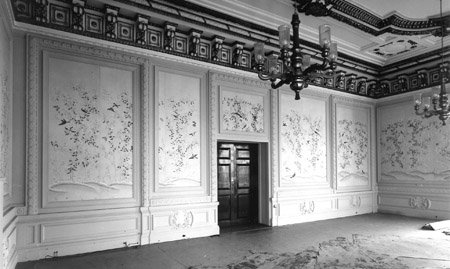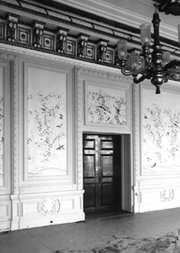Published in British Academy Review, No. 32 (Spring 2018).
The print version of this article can be downloaded as a PDF file.
The British Academy has been in its present home for 20 years. On Monday 2 March 1998, the Academy started its new life at 10-11 Carlton House Terrace, London SW1.
One year earlier, in March 1997, the Academy’s Secretary, Mr Peter Brown, had produced a briefing document for the Fellows of the Academy, to explain the thinking behind the proposed move, and – more importantly – to lay out the fundraising challenge to make it possible.
The following extracts from the document give a flavour of the vision.
The move to new Headquarters in 10-11 Carlton House Terrace: project summary
The aim is to establish the British Academy in new headquarters, alongside the Royal Society, thus bringing together the national academies for the natural sciences and for the humanities and social sciences.
This involves refurbishment and adaptation of a Grade I listed building, which has been badly neglected internally in recent years, so as to restore it for public access and use, and to meet the Academy’s needs, at a total cost of approximately £3 million, of which it is for the Academy to raise two-thirds.
Establishing the British Academy in its new premises will
- give it, and the subjects it promotes, higher public visibility;
- help to safeguard its independence as a standard-bearer for scholarly excellence;
- enable it further to develop and expand its research programmes;
- make it a centre for the scholarly community, learned societies, and the general educated public;
- ensure that the Academy’s work in promoting and supporting research and scholarship is carried on and enhanced into the next century; and
- through co-operation with the Royal Society, lead to interdisciplinary joint activities bringing together the natural sciences and the humanities and the social sciences.
The move will place at the Academy’s disposal, for the first time in its history, a suitable number of public rooms, which will enable it to organise properly its own academic meetings, workshops, lectures and symposia, and offer facilities to the Fellowship and as a service to the learned community and the public at large. It will thus be possible to give real substance to the claim to be the national Academy for the humanities and the social sciences, promoting those disciplines not merely through facilitating grants but by means of its own initiatives and activities.
The reasons for wishing to move to new premises
Over recent years there has been a growth in the British Academy’s size, responsibilities and activities, to the point that the headquarters in Regent’s Park, which it has occupied since 1982, have come to be regarded as unsatisfactory. The public rooms are inadequate, too few and too small for the needs of the Fellowship, for the increasing number and range of academic committees that meet under the Academy’s auspices, and for the conferences and symposia that the Academy sponsors. There is no office accommodation for the President and Officers, and the office space is insufficient for the present administrative staff of 35, some of whom are located in Stanmore. The Academy is keen to develop its activities further, but has been prevented from doing so by lack of space and facilities.
The Crown Estate Commissioners, the Academy’s landlords, have now offered a 50-year lease of 10-11 Carlton House Terrace, a building which has approximately three times as much space as the present premises. The building is ideally situated, next to the Royal Society, which will have the effect of bringing together the two principal national academies covering all branches of knowledge. There is already co-operation with the Royal Society at various levels, notably in organising joint meetings. Their new proximity, both parties intend, will lead to much closer and more regular co-operation, and discussions are in progress with the aim of sharing certain facilities and services.
As the President said in announcing the move to Fellows:
‘This development presents us with a splendid opportunity and challenge. It will provide for all our present needs, and I believe that it has the potential to transform the Academy and its activities beyond recognition.’

That the move was able to take place in March 1998 (if three months behind the original schedule) was due to the success of the fundraising work. Generous funding to make the move possible at all was made available by the Department for Education and Employment (as it then was). But there were then important donations from private sources towards the costs of the refurbishment: the Wellcome Trust; Mr Lee Seng Tee; the Rhodes Trust; the Wolfson Foundation; the Nuffield Foundation; the Michael Marks Charitable Trust; the Rayne Foundation; the Aurelius Trust; four Oxford colleges (All Souls, Balliol, Christ Church, Nuffield); and five Cambridge colleges (Christ’s, Gonville and Caius, Jesus, St John’s, Trinity). And there were also donations from many Fellows of the British Academy and other individuals.
According to current President of the British Academy, Professor Sir David Cannadine,
‘We remain ever in debt to those who devised the move to Carlton House Terrace and those whose generosity made it possible in practice. The challenge articulated 20 years ago – that the move should enable the British Academy and its activities to be transformed “beyond recognition” – is one that I think we are well on the way to meeting. In a building with such splendid spaces, and one so magnificently situated, the Academy has grown in stature, and it now confidently assumes the national role envisioned for it two decades ago. But the task of transforming the Academy “beyond recognition” perforce remains unfinished, and it is now our task, our responsibility and our opportunity to drive the Academy further forward and onward in our own time. Inspired and encouraged by these earlier achievements, it is a challenge which we relish and welcome.’
How are we doing? Your feedback is important to help us shape future issues of the British Academy Review.
To provide reader feedback, please visit www.britishacademy.ac.uk/british-academy-review-feedback
